
Triadenum, known as marsh St. John's worts, is a small genus of flowering plants in the family Hypericaceae. The genus is characterized by opposite, blunt-tipped leaves and pink flowers with 9 stamens. They are distributed in North America and eastern Asia.
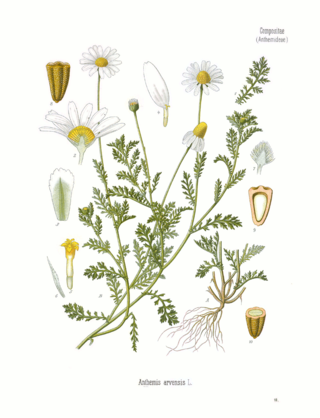
Anthemis arvensis, also known as corn chamomile, mayweed, scentless chamomile, or field chamomile is a species of flowering plant in the genus Anthemis, in the aster family. It is used as an ornamental plant.
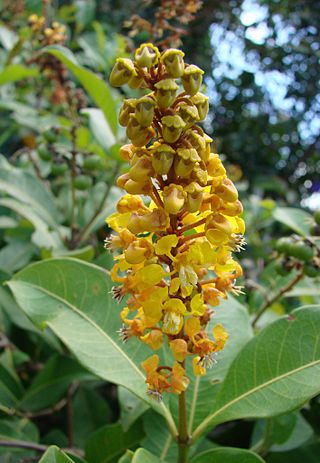
Byrsonima is one of about 75 genera in the Malpighiaceae, a family of flowering plants in the order Malpighiales. In particular in American English, they are known as locustberries. Another widely seen common name is serrets or serrettes.
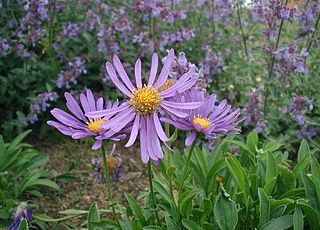
Aster alpinus, the alpine aster or blue alpine daisy, is a species of flowering plant in the family Asteraceae, native to the mountains of Europe, with a subspecies native to Canada and the United States. This herbaceous perennial has purple, pink, or blue flowers in summer.

Stellaria graminea is a species of flowering plant in the family Caryophyllaceae known by the common names common starwort, grass-leaved stitchwort, lesser stitchwort and grass-like starwort.

Plumeria obtusa, the Singapore graveyard flower, is a species of the genus Plumeria (Apocynaceae). It is native to the Neotropics, but widely cultivated for its ornamental and fragrant flowers around the world, where suitably warm climate exists.

Stuckenia pectinata, commonly called sago pondweed or fennel pondweed, and sometimes called ribbon weed, is a cosmopolitan water plant species that grows in fresh and brackish water on all continents except Antarctica.

Dryopteris cristata is a species of fern native to wetlands throughout the Northern Hemisphere. It is known as crested wood fern, crested buckler-fern or crested shieldfern. This plant is a tetraploid species of hybrid origin, one parent being Dryopteris ludoviciana and the other being the unknown, apparently extinct species, dubbed Dryopteris semicristata, which is also one of the presumed parents of Dryopteris carthusiana. D. cristata in turn is one of the parents of Dryopteris clintoniana, another fern of hybrid origin.

Sagittaria montevidensis is a species of flowering plant in the water-plantain family Alismataceae. Common names include giant arrowhead and California arrowhead.
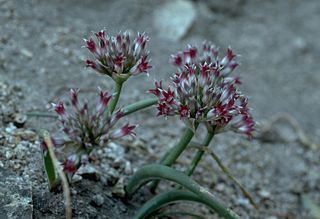
Allium monticola is an uncommon species of wild onion known by the common name San Bernardino Mountain onion. It is endemic to southern California, where it is found in the Transverse Ranges and the northernmost section of the Peninsular Ranges. It has been reported from San Bernardino, Los Angeles, Orange, Ventura and Santa Barbara Counties.

Alyssum desertorum is a species of flowering plant in the family Brassicaceae known by the common name desert madwort. It is native to Europe, North Africa and Asia, and it is found in parts of western North America as an introduced species and sometimes a weed. This is a hairy annual herb producing upright stems up to about 20 centimeters tall. The leaves are linear to oblanceolate-linear in shape, 0.5-4 millimeters long and 0.3-3 millimeters wide. The entire plant is covered by 8-20 rayed stellate trichomes, giving the plant a grayish appearance. It produces small yellowish flowers with petals that are 2-2.5 millimeters long and round, notched fruits 2.5-4.5 millimeters long. The brown seeds are winged, arranged two to a locule, and are about 1.5 millimeters long.
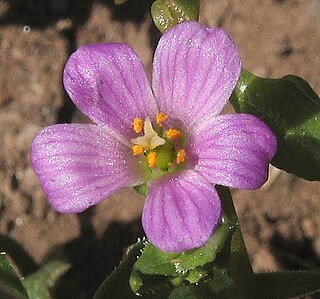
Calandrinia breweri is a species of flowering plant in the family Montiaceae known by the common name Brewer's redmaids.
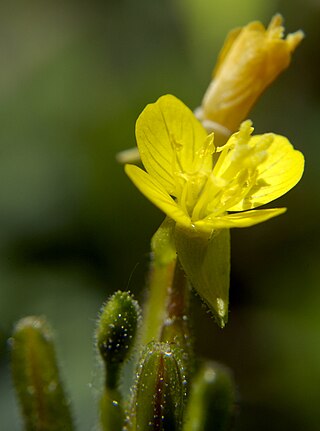
Oenothera perennis is a species of flowering plant in the family Onagraceae and is native to the eastern United States and Canada. Its common names include little evening primrose, small sundrops, and small evening primrose. Its native habitats include shaly slopes, moist or dry fields, pastures and roadsides. Oenothera perennis is a perennial herb. It has yellow flowers that open during the day and close at night. Each flower has four petals that are notched at the tip with veins radiating from the base.
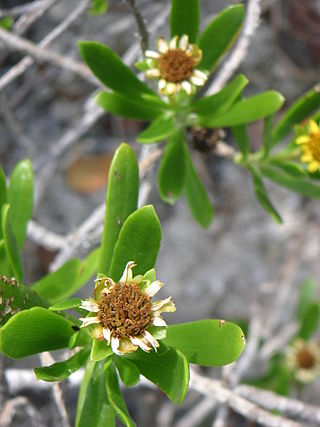
Borrichia is a genus of flowering plants in the family Asteraceae. It is named for Danish physician Ole Borch (1628–1690). Members of the genus are commonly known as seaside tansies. They are native to North and South America.

Poa secunda is a widespread species of perennial bunchgrass native to North and South America. It is highly resistant to drought conditions, and provides excellent fodder; and has also been used in controlling soil erosion, and as revegetator, often after forest fires. Cultivars include 'Canbar', 'Service', 'Sherman', and 'Supernova'. Historically, indigenous Americans, such as the Gosiute of Utah, have used P. secunda for food. It was originally described botanically in 1830 by Jan Svatopluk Presl, from a holotype collected from Chile by Thaddäus Haenke in 1790.

Cirsium eatonii, commonly known as Eaton's thistle or mountaintop thistle, is a North American species of flowering plants in the family Asteraceae.

Triumfetta rhomboidea, commonly known as diamond burbark, Chinese bur, or kulutkulutan in Tagalog, is a shrub that is extensively naturalised in tropical regions. It is thought that to have come to Australia from China. Its bark—sometimes called burbark--makes a kind of jute.
Najas filifolia, the needleleaf waternymph, is an aquatic plant in the Hydrocharitaceae. It is a rare and little-known species, known from only three counties (Decatur County, Georgia; Santa Rosa County, Florida; and Leon County, Florida. It is unusual in the genus in bearing fruits that are recurved to crescent-shaped.
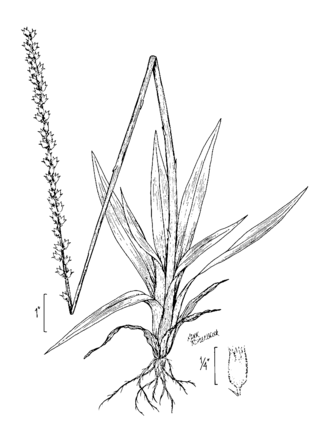
Aletris aurea is a plant species native to the southeastern United States from eastern Texas and southeastern Oklahoma to Maryland.
Vitis × champinii, or Champin's grape, is a hybrid grape resulting from the natural hybridization of Vitis mustangensis with Vitis rupestris. Its native range is the Edwards Plateau in Texas.



















